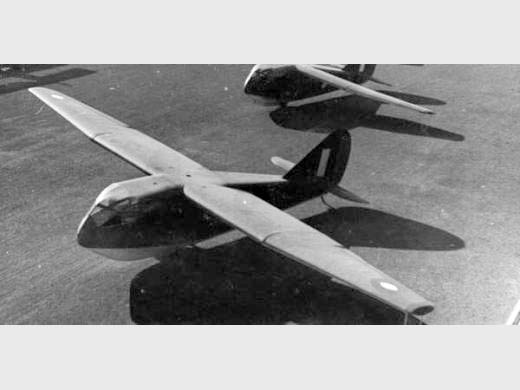
De Havilland DHA G-2
Autre nom (ou nom en langue originelle) : RAAF A57 - De Havilland EG-2| DONNÉES GÉNÉRALES |
| Année du premier vol (ou de design, si seul projet) |
1942 |
| Pays | Australie |
| Designer(s) | De Havilland |
| Premier constructeur | De Havilland Aircraft, Bankstown (NSW, Australie) |
| Type d'appareil | Planeur |
| Fonction | Militaire |
| SPÉCIFICATIONS TECHNIQUES |
| Envergure | 15.39 m |
| Longueur | 10.06 m |
| Hauteur | 2.14 m |
| Allongement | -- |
| Surface alaire | -- |
| Profil aile | -- |
| Masse à vide | 658 kg |
| Masse maxi | 1474 kg |
| Charge alaire | -- |
| Vitesse mini | -- |
| Vitesse maxi | 322 km/h |
| Finesse maxi | |
| Taux de chute mini | -- |
| Nb sièges | 7 |
| Structure | Tout bois. |
AUTRES INFORMATIONS
| Constructeur(s) |
| ||||||
| Infos techniques | The EG-1 differed from the few EG-2 in that the 60-foot span wing was a one-piece strait-tapered structure. The EG-2 had a shorter wing of only 50'6" which was tapered from a point just inboard of the aileron root. Layout was quite conventional, when compared to contemporary military gliders under development in other countries, and construction was all wood. No mention can be found of the troop capacity of the design, but weight figures and the width of the fuselage indicate a military load of approximately five troops and the pilot. Specifications for the EG-2 are : span 50'6", lenght 33', fuselage width 5' fuselage height 7', empty weight 1450 pounds, gross weight 3250 ppounds, wing loading 9,7 pound per square foot. The performance figures are remarkable - maximum speed 200 mph, towing speed 130 mph and stalling speed 48 mph. | ||||||
| Histoire résumée | During World War II the Australian Government issued specifications 5/42 for a small troop-carrying militarv glider, and the De Havilland EG-l and EG-2 (A57-1001 and 1002) designs built by de Havilland Aircraft at Bankstown, NSW, were the result. The 2 prototypes were handed over to the RAAF on 11 November 1942.). The letters identifying the design were almost unbelievably direct -EG stood for "Experimental Glider.". It was envisaged that they would be produced in large numbers to fly troops to meet any Japanese invasion, and would be towed by such aircraft as the Fairey Battle and Vultee Vengeance. When the invasion threat did not materialise, only six aircrafts were produced with longer wings and fuselages than the two prototypes. Le premier exemplaire A57-1 fut modifié pour des essais d'aile à succion de type Griffith (voir De Havilland G-2 Glas II). The remaining aircraft (A57-2 to 6) were little used and were reduced to components by 1952. A subsequent 15 place glider design, GC-4A, was proposed but never built. | ||||||
| Liens personnalités | Pas de personnalité associée. | ||||||
| Compléments docs |
SOURCES DOCUMENTAIRES
| Liens WEB | Site : Site Уголок неба (Coin de Ciel / Sky Corner) . Texte + 4 photos + specs. (2023-12-23 CL) Site : RAAF Museum . Note + specs. (2010-06-14 CL) Site : 1000 Aircrafts Photos . Note + 1 photo. Photo du premier prototype A57-1 (2010-06-14 CL) Site : ADF Aircrafts Serial Numbers . Liste des appareils enregistrés + 1 photo. (2010-06-14 CL) |
| Livres | Pas de livre référencé. |
| Autres sources | Soaring Magazine août 1959 p 19. Note sur les prototypes EG-1 et EG-2 + photo (EG-2). |

Team J2mcL © 2003 -
- Pages optimisées pour Mozilla Firefox

